This time, THM correspondent, Jess Willard is on the other side of the process – instead of recording the exploits of others, Jess is the subject of our story as she takes a lesson with dressage coach, Clemens Dierks. Chris Hector was there to write the story, Roz Neave to take the photos…
The whole ‘lesson with’ concept is fraught with danger – the biggest fear is that you will see no change in either horse or rider in the course of the lesson. And that is really not all that surprising since the equestrian art is subtle beast, changes take time and patience and often the results of a perfectly good lesson will not be seen until weeks, months, later. Luckily this was not the case when we threw talented young dressage rider, Jess Willard into the manege at the Dierks Training Stables, with Clemens Dierks in his customary teaching spot, sitting in the gazebo on the hill behind A.
Jess has had considerable success with her school-master, Sienna Tailor Made and is now facing up to the challenge of training her first young horse, the seven year old Jackson (Jive Magic / Medallion). The gelding is not a naturally huge mover and when they first start trotting around the arena, he is stepping very short behind, and Clemens is quick with his advice…
“He must give more from behind, his hind legs must track up under him. Move! Give him a little kick, and then allow, if you hang on they can’t step up, his hind legs don’t really step into the front hoof prints. Half halt and ask for a bigger stride, but don’t let him get stronger. Speed doesn’t come into it, the stride can be huge without being fast, when they get fast, they go shorter…”
But this time, Clemens decides that every rule has its exception, the gelding has got so used to stepping short that he needs to run to get some action happening:
“Go across the diagonal and really get going, even if he loses balance. Instead of lengthening he runs – let him run because he hasn’t learnt to extend, there is no suspension. Even through the corners ride medium. The horse has been born without a lot of extension in his trot, but we have to improve it. The problem with this horse is that he has not cadence, no suspension, my recommendation in this case is to make him really go. If he canters, come back immediately to trot and go again. You have to be prepared to experiment, let’s try this and see if it works…”
“He is not coming through, kick, but don’t hang on, give. Sure he will try to canter, it is easier for him to canter, but keep bringing him back to trot and make him go again, horses learn from repetition. Keep going, don’t pull back, just ride – and see now, as soon as he stretches and gets some suspension, he goes slower – not because you are holding him, but because you are allowing. See we have a slight moment of suspension – more, more, don’t hold back, don’t let him dive. Good, now we are getting some over-step.”
“Ride him through a ten-metre corner, not a six-metre corner, or he will fall over. Circles are good for him because he has to slow down, but keep riding him forward so we get that longer stride. Normally I have to slow riders down, this is the exception. Okay, he canters, go straight back and ride him forward again, it is the first three strides that are important, get them and you will get them all. Okay, he is a little running but the stride is bigger. This time when you go across the diagonal, push, then half halt, get the trot slower but still active and engaged. The horse can’t lengthen his front legs until the hind legs come. Circle now, half halt, almost walk but big steps. Now the hind legs step into the print of the front legs.”
Jess had complained at the beginning of the lesson that the horse could get heavy in her hands and Clemens explained that it was part of the short step problem:
“If you sit there and hold more than you drive, the horse will be heavy. Ride him this way and you might have a little argument, but if you do it with skill, then comes progress. No argument – no progress. Go to sitting trot, you can’t drive from rising trot. Extend now while you slow down, bring him up, now the hind leg comes, now he starts to swing.”
And truly we are watching a very different horse.
Time to try some lateral work.
“Go to shoulder in, but you must not reduce the stride, collected trot still covers ground. In shoulder in, your score will only be as good as your pace. The key is the trot, not the shoulder in. If the trot is an 8, then the shoulder in is 8. If your inside leg is too far back in shoulder in, then the horse can’t bend. Get your outside leg back, that puts your seat in position, on your inside seat bone.”
“Now go to travers on the diagonal, big trot, more forward. The big mistake in half pass is driving sideways, the movement is really travers right up to the Grand Prix test. Soft with the inside rein, or you get a head tilt.”
Clemens wanted Jess to work on her canter work, but Jackson suddenly decided that there was a monster in the far corner: “Let him have a look, keep him a bit shoulder fore. You can’t out-power the horse, you’ve got to out-smart them – give, pulling won’t fix a spooky horse.”
“Now canter, and have him up in front for the canter. Too light is more wrong that a bit strong. Circle and push the hind leg under. Push, then soft, good.”
Jess said that she had been having problems with her flying changes, and sure enough when she asked for a change, Jackson changed early in front.
“Think travers and think only change behind. No he has changed in front, go back to counter canter and correct the problem.”
“He was really late that time, but I can guarantee we can fix this problem and he will have perfect changes. Maybe not in one hour, but we can fix this problem. Some horses that are difficult to teach the flying change, end up more expressive when they get them. Don’t let the front change, even if it looks rough. Put him in counter canter and really collect and go to walk, no change. Counter canter again, more back, more collection, active hindleg, sit him back. Make sure the poll is always the highest spot – your position is better than the horse’s. Counter canter, collect, counter canter, collect, and now…”
And this time it is a perfect flying change.
“The collection activates the hind legs and doesn’t allow the front legs to jump.”
Back to trot to reinforce the first lesson.
“In trot, really half halt to get the hind leg. Half halt, do not pull, now the trot is slower but more active. The horse does all the tricks, but it is the pace and the frame that you have to work on. He is not born with paces for a 10, but it can all be improved.”
As we have just seen… thank you Jess and Jackson, thanks Clemens…
Clemens Dierks – you have to experiment…
When this horse started it really wasn’t moving at all…
“You could see in the warm up, Jess wasn’t riding the horse, letting the horse trot around and sitting on it, instead of right from the beginning making sure that your trot has the right amount of engagement. I don’t mind if they want to warm the horse up lower, but they must not be on the forehand. The horse stepped very short at the beginning, that’s not because it is stiff, it is because it has been let get away with it. Anything that is wrong, you must correct it immediately, you can’t ride twenty circles bad trot without any correction, that doesn’t work.”
“The horse actually responded very well, and moved better with more cadence, more engagement, more expression, and started to look very good when Jess asked more from him…”
It was interesting that you were prepared to let the horse almost run out of rhythm…
“I experimented. I wanted to see if he could actually stretch out enough. With some horses you just have to go once to see if they can produce a longer stride and a bit of suspension. Some horses are just born with great movement and expression, but this one is not born with that, but we can help him.”
“In all the paces, he has not been ridden from behind. The rider sits, with the outline too deep, and nothing happens… But the horse proved he can improve if he is worked more forward.”
When you asked her to ride the horse more up, to use the half halts, his way of going totally changed…
“Totally different… half halt must be a give and take. There are only three things you can do with your reins, give, take and halt. If there is no give, it becomes a pull and the horse becomes heavier. The half halt is something like learning to ride a bike – it is practice, finding out what the horse responds to. Every horse if different. You can say, you take this much weight, or how sharp, or how soft, it depends on the horse, but we must have what they call in German, unleaven, you must have contact where the horse takes you. If the reins get too loose, you lose control. You can’t ride a dressage test if you have to kick the horse, the horse has to take you, he has to have enough ‘nerve’ to go, if they are too loose in the contact, then when the rider takes back, it is too sharp, you need that contact to get the horse soft…”
Jess Willard
“It was a fantastic lesson. It is always a bit of a tune up when I see Clemens. It’s probably close to six months since I had a lesson with him and I think the last time he saw the horse, we were having a lot of trouble with changes and that had messed up a lot of our other basic work – I had to go back to square-one. It was good today to come back and feel that everything is more consolidated, but then ask for more – more in his paces, more expression. I just really needed the tune up, it was good.”
“The last few months have just been about getting the horse’s confidence back. In the last month or so, it has felt quite weak, I feel like I am working hard but not necessarily getting the right reactions from the horse. It always helps when someone is watching you and saying ‘you need more power’ – I could really feel the difference between how he was going in the beginning of the lesson, and how he was going at the end. It is always difficult to push yourself that far, you need someone on the ground to help.”
“It’s hard for me, I don’t come from a horsey family, I ride at home by myself all the time. I have struggled finding an instructor that I click with and get the right result from the horse – but also someone you can fit into your routine so it becomes a regular experience. With Clemens, the help has been quite sporadic, he first saw the horse eighteen months ago, and it takes a while for him to remember, oh yes, this is what that horse does. What I find is he always remembers the bad things, so you are trotting around and he goes ‘oh this is the spooky horse’. But it is good with Clemens because he is brutally honest and this is the first young horse I’ve trained, and every time I’ve gone back to him, he has always said, this is better. That is re-assuring.”
“Now I’ve got lots of homework, and if I come back in a month’s time and it is no better, then I’m sure he wouldn’t bother with me. If you are improving he is always prepared to work hard to help you. That’s the first real lesson I’ve had in a while and I really needed it.”

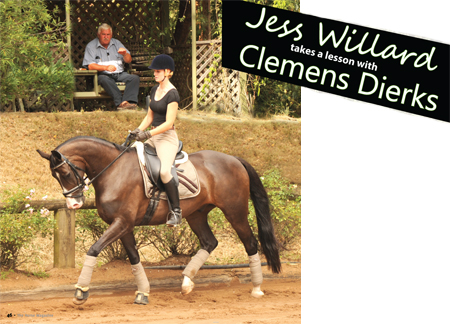
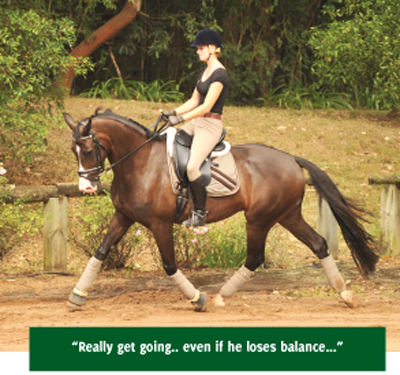
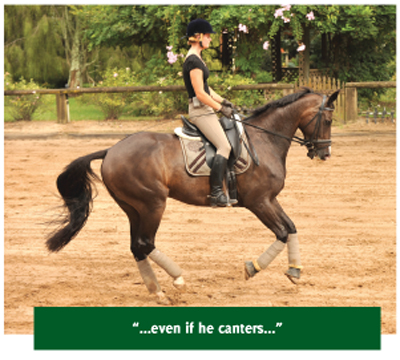
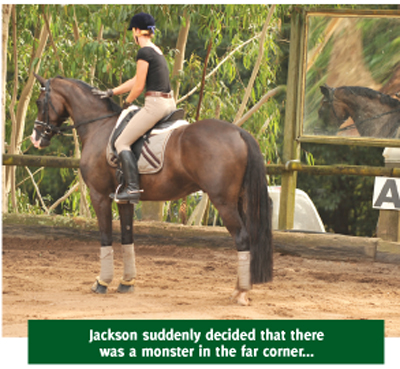
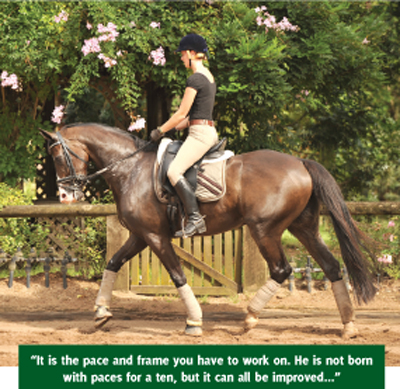
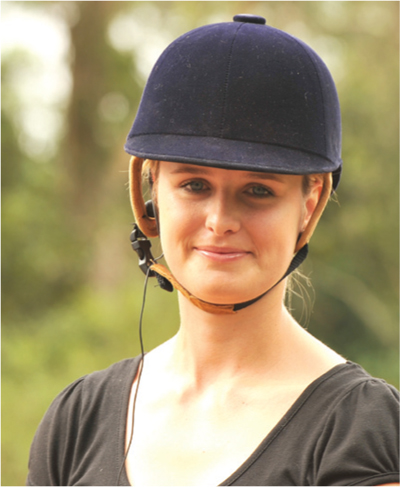
In the trot pictures the horse’s face is behind the vertical. This is an evasion, and is either induced by too strong a contact from the rider, or an avoidance by the horse to accept a contact. It should be corrected by the rider. There should be no need for a flash nose band or a nose band all for that matter.